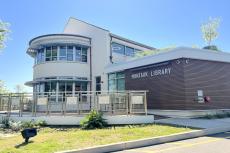The Democratic Party on the East End is turning to a new voter base: second-home owners.
According to the Suffolk County Board of Elections, 876 people with mailing addresses in New York City were registered to vote in East Hampton Town as of August 2020: 672 were Democrats, 77 were Republicans, and 110 listed no party affiliation.
The number of New Yorkers registered in East Hampton has grown over the past 20 years, and the number of New Yorkers registering in East Hampton spiked in 2018 (when 404 New Yorkers registered) before the midterm elections.
One reason is that New York City is politically dominated by Democrats, therefore a Democratic vote in New York City carries less weight. But a Democratic vote on the South Fork can make more of a difference because the First Congressional District of which it is a part is more politically balanced.
New York's First Congressional District encompasses most of central and eastern Suffolk County; however, it has not had a strong party affiliation. In the past 50 years, the district has had relatively equal time being represented by Republicans and Democrats. It is represented now by Lee Zeldin, a Republican first elected in 2014. His opponent this year, the Democratic Nancy Goroff, is making her first run for public office. Before Mr. Zeldin, the seat was held by the Democrat Tim Bishop from 2003 to 2015, and before that by a Republican, Felix Grucci.
Cate Rogers, the chairwoman of the East Hampton Democratic Committee, has been heavily engaged in the process of getting New Yorkers to register in their second home on the South Fork. She said that this was not a novel strategy; the Democratic Party has been trying to get New Yorkers to register on the South Fork since at least the 1980s.
The Democratic Party on the South Fork has traditionally stood for conservation and zoning laws to preserve the natural and human geography of the South Fork, she said. "The Republicans favored development, and the Democrats favored conservation." This message hit home with both year-round South Fork residents and New Yorkers who didn't want to see their summer home turned into a "Miami Beach of the Northeast," as Ms. Rogers said.
Ms. Rogers said that there wasn't a large ideological rift between New Yorkers and year-round resident voters on the South Fork, as many of the key issues of the Democratic Party on the South Fork are important to both groups.
An issue that Ms. Rogers mentioned as key to Democrats in East Hampton was immigration. Democrats focused on the protection of the growing immigrant and largely Spanish-speaking population on the South Fork -- something that has helped gain the Democratic Party votes on both a districtwide and local level. Hispanics and Latinos have been increasing in every Suffolk County township by more than 10 percent, according to United States Census data from 2010.
Make the Road Action, a group that represents immigrant populations across the United States, wrote in 2016, "Latino voters are poised to have a decisive impact on the November elections in New York, accounting for 12 percent of registered voters statewide and substantial percentages in key swing districts."
Kyle Vorpahl, a former secretary of the East Hampton Town Republican Committee, was critical of the Democrats' strategy, saying that it gave them an unfair advantage that allows for "no discourse" and that the local government of East Hampton is so dominated by the Democrats that all policies are simply "pushed through by the Democrats." He also noted that New Yorkers who come to the South Fork are more likely to "vote blindly." Mr. Vorpahl added that, oftentimes, New Yorkers tended to be more interested in party affiliation than the nuances of local politics.
Allen Cutler, a retired New York banker and staunch Democrat who switched his voter registration to the South Fork after being canvassed by Democrats, echoed many of Ms. Rogers's points. "It was clear to me that voting in New York as a Democrat was not potent and I felt that my vote would count more in a district that was more politically balanced," he said. He said he cared more about national issues than local issues but mentioned his focus on conservation and the immigrant population on the South Fork.
When asked about Mr. Vorpahl's point on "blind voting," Mr. Cutler said that since he pays taxes on the South Fork he should be able to vote. "It is my legal right to vote [on the South Fork] and I see no reason why I shouldn't take advantage of it."
--
Luke P. Gutman was a participant in The Star's summer 2020 student journalism program.



